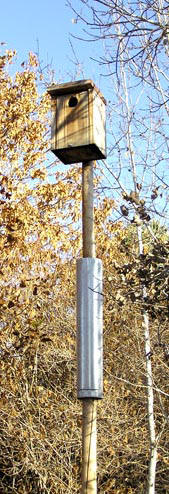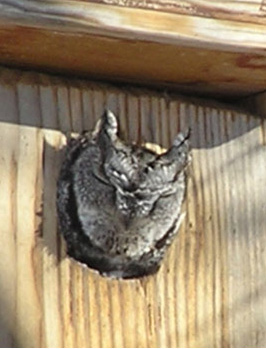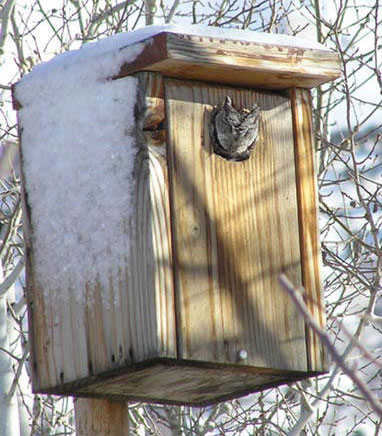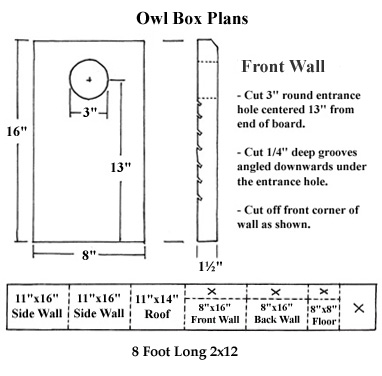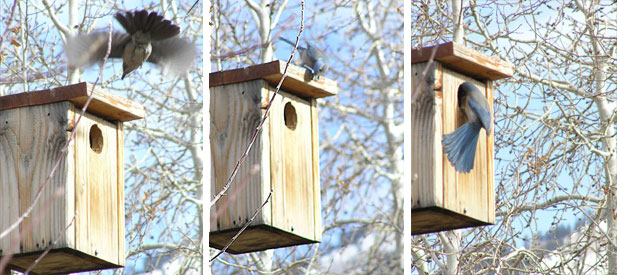|
Western Screech-Owl Nest
Box
|
Nesting Reports: Owl Family
2004 |
||||||||||
|
|
|||||||||||
W hen you think of birdhouses you think of birds like Bluebirds, Titmice, House Wrens, Tree Swallows, and Purple Martins. But these are all birds that would never nest in my yard. I bet most of you live in a residential area as I do and Iím going to assume these species wouldnít nest in your yard either.So what would be the easiest bird to entice to a nest box in our yards? Thatís right, House Sparrows. But you probably already have enough of those. So whatís the second easiest? You probably donít want Starlings either. How about the third? Black-capped Chickadee maybe? Well, Iím not writing about chickadees. Iím writing about the fourth easiest, and by far the coolest, species to attract to a nest box in a suburban setting along the Wasatch Front... Western Screech-Owls.
Almost every description of screech-owl habitat Iíve read mentions the use of suburban areas. (Kaufman and NG Field Guides for example). Robert A. Behrstock writes in The Sibley Guide to Bird Life & Behavior, "Habitat loss associated with human residential development has had an impact, usually a detrimental one, on many species. However, Eastern Screech-Owls inhabiting neighborhoods with mature trees may have higher survival rates than countryside populations, thanks to a lower diversity of predators, greater availability of water and of prey attracted to bird feeders and garbage cans, the suitability of lawns as hunting areas, and the warmer conditions associated with urban enclaves." One of my first sightings of screech-owls was when Ned Hill showed me some from a parking lot next to the BYU Campus and this year screech-owls raised several young in a tree right next to the busiest sidewalk at UVSC. I know what youíre thinking: "Iíve never seen a screech-owl in my yard!" Well thatís because they are very sneaky. Iíve got owls in my backyard and I have to make an effort to be outside at just the right time to see them. In fact they were nesting in my yard for a month before I even knew it. Your neighborhood is likely good screech-owl habitat. Your bird food at night becomes mouse food and if your neighborsí cats are like my neighborsí cats, they fill up on birds all day - which leaves your mice predator-free. But screech-owl population growth in such habitat is limited to the availability of nesting cavities. People seldom let old rotten trees stand in their yard. They could fall and hurt someone. Well-built nest boxes seldom fall on people and screech-owls like them just as well as trees. ( http://www.cornell.edu/: "Both species [Eastern and Western Screech-Owls] use nest boxes, and field studies show that boxes are selected as often as natural cavities for nest sites.")
Screech-owl boxes need an interior floor size of at least 8" x 8" and at most 9" x 10". (Most specifications I found suggested 8" x 8"). The inside height should be from 14" to 17" and the hole needs to be a 3" diameter circle and should be centered 11" to 13" above the floor. You should also put some drain holes in the floor, cut some notches on the inside front wall to help the young owls climb out and place an inch or two of wood shavings in the bottom. I built my box out of 2xís which is heavier wood than youíll find in most instructions, but I think the thicker the better. I sandwiched a 2x10 (actual measurements 1Ĺ" x 9") front and back wall between 2x12 (actual measurements 1Ĺ" x 11") sides which made an interior floor size of 8" x 9". (If you cut the front and back wall to 8" wide you can fit a 2x12 roof on top.) I nailed the front wall on with two nails at the same height near the top of the wall and put one removable screw-bolt at the bottom so I can unscrew the bolt and swivel the front wall up to clean out the box. I buried a 16' Pole 3' in the ground in the quietest corner of the yard, put the box on top and a predator guard around the pole. (You may have raccoons in your yard and not know it. They are very sneaky also.) If you live in a neighborhood with open space and few trees, this same size box will be used by kestrels. If you have a cabin up in the mountains and cut the entrance hole to 2 Ĺ" the box could be used by Flammulated and Saw-whet Owls. ( Click here for Printable instructions PDF)I need to warn you that screech-owls may not find your box right away and if they donít, starlings will use it. If this happens just open the front of the box every couple weeks, take out the eggs and feed them to your pet snake or put them on the tray feeder with the peanuts for the jays and magpies. In any case, if you patiently put up with starlings, it will eventually pay off when the owls move in because thatís when the fun starts. At dusk just as itís getting dark but before itís too dark to see you can go out and, watching quietly from a distance, see a previously mysterious, seldom seen creature out on the prowl hunting for mice over the bird feeders or snatching moths from the flower garden and taking them back to the nest. Once they find the box theyíll likely stay in your yard year round. It is now November and when the sun hits my nest box just right I will sometimes see a screech-owl sitting at the entrance sunning itself. They will add a nice touch of nature to your otherwise boring yard.
Next Page - Nesting Report - May 3, Hungry Mouths to Feed Build You Own Nest Box - Plans & Instructions (PDF) Instructions from the UK |
|||||||||||
